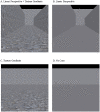The contribution of linear perspective cues and texture gradients in the perceptual rescaling of stimuli inside a Ponzo illusion corridor
- PMID: 31600294
- PMCID: PMC6786755
- DOI: 10.1371/journal.pone.0223583
The contribution of linear perspective cues and texture gradients in the perceptual rescaling of stimuli inside a Ponzo illusion corridor
Abstract
We examined the influence of linear perspective cues and texture gradients in the perceptual rescaling of stimuli over a highly-salient Ponzo illusion of a corridor. We performed two experiments using the Method of Constant Stimuli where participants judged the size of one of two rings. In experiment 1, one ring was presented in the upper visual-field at the end of the corridor and the other in the lower visual-field at the front of the corridor. The perceived size of the top and bottom rings changed as a function of the availability of linear perspective and textures. In experiment 2, only one ring was presented either at the top or the bottom of the image. The perceived size of the top but not the bottom ring changed as a function of the availability of linear perspective and textures. In both experiments, the effects of the cues were additive. Perceptual rescaling was also stronger for the top compared to the bottom ring. Additional eye-tracking revealed that participants tended to gaze more in the upper than the lower visual-field. These findings indicate that top-down mechanisms provide an important contribution to the Ponzo illusion. Nonetheless, additional maximum likelihood estimation analyses revealed that linear perspective fulfilled a greater contribution in experiment 2, which is suggestive of a bottom-up mechanism. We conclude that both top-down and bottom-up mechanisms play important roles. However, the former seems to fulfil a more prominent role when both stimuli are presented in the image.
Conflict of interest statement
The authors have declared that no competing interests exist.
Figures







References
-
- Sperandio I, Chouinard PA. The Mechanisms of Size Constancy. Multisens Res. 2015;28(3–4):253–83. - PubMed
-
- Cutting JE, Vishton PM. Perceiving layout: The integration, relative dominance, and contextual use of different information about depth In: Epstein W, Rogers S, editors. Handbook of Perception and Cognition. 5 NY: Academic Press; 1995. pp. 69–117.
-
- Gregory RL. Eye and brain: the psychology of seeing. 5th ed Oxford; New York: Oxford University Press; 1998. pp. 277–80.
Publication types
MeSH terms
LinkOut - more resources
Full Text Sources

